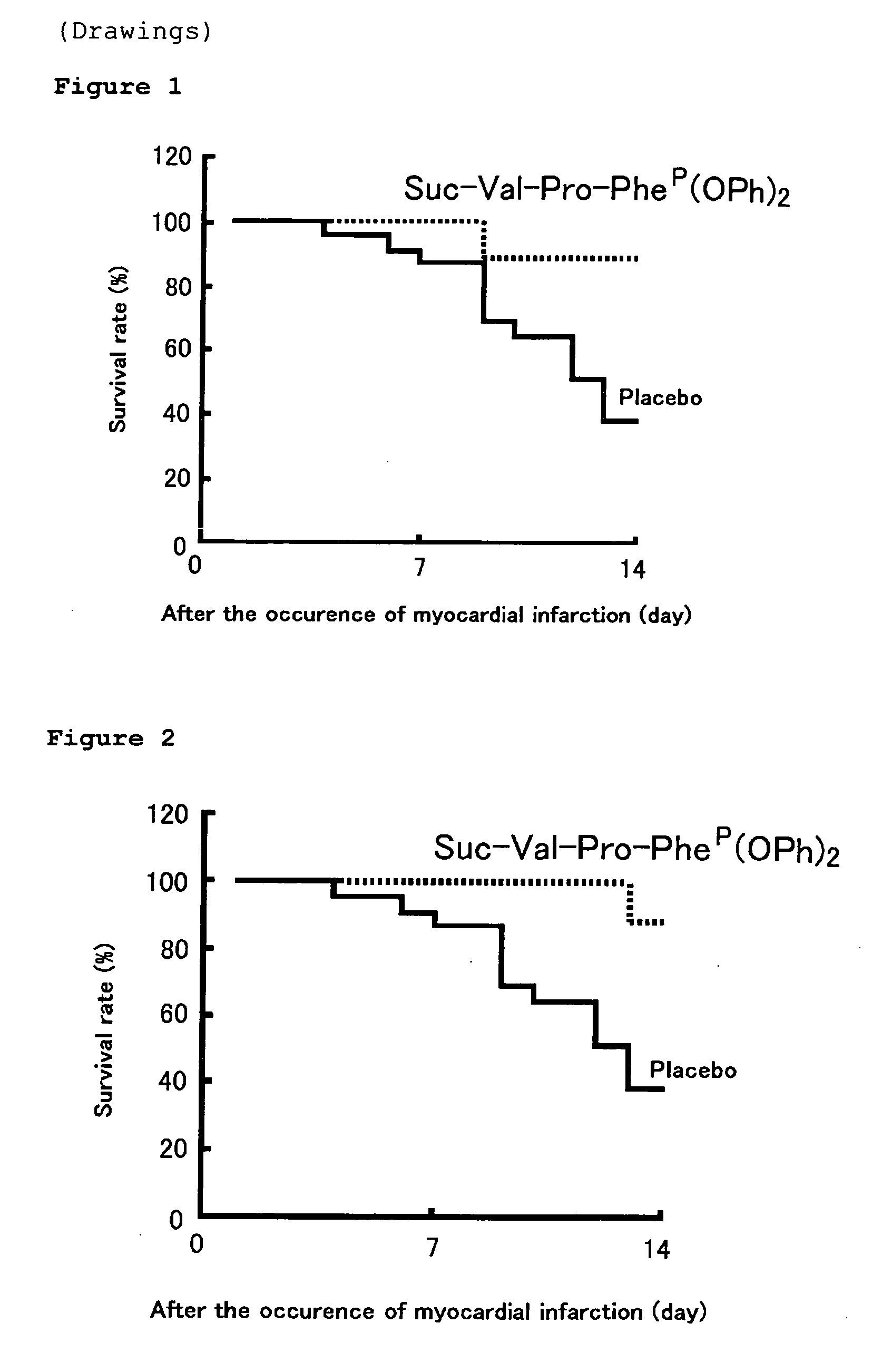Cardioprotective agent
a protease inhibitor and cardiac technology, applied in the direction of peptide/protein ingredients, peptide sources, metabolic disorders, etc., can solve the problems of not bringing under a specific condition a sufficient effect on thrombosis, not sufficiently recovering cardiac functions, and completely dissolving ischemia
- Summary
- Abstract
- Description
- Claims
- Application Information
AI Technical Summary
Benefits of technology
Problems solved by technology
Method used
Image
Examples
example 1
Preparation of Aminoalkylphosphonic Acid Derivatives
[0057] Agents comprising peptidyl derivatives of aryl diesters of aminoalkylphosphonic acid have been demonstrated and performed by one of the prior art (Biochemistry, 30, p. 485-493, 1991).
[0058] To elucidate the relationship between chymase activity and adhesion formation, the effect of a representative serine protease inhibitor, the chymase inhibitor, Suc-Val-Pro-PheP(OPh)2, was tested. This compound has been synthesized using a known methodology (Biochemistry, 30, p. 485-493, 1991). More specifically, the reaction of Cbz-Val-OH (0.25 g, 1 mmol), DCC (0.2 g, 1 mmol) and the product of hydrogenolysis of Cbz-Val-Pro-PheP(OPh)2 (0.584 g, 1 mmol) were dissolved in 30 ml of ethyl acetate and oil was added thereto. To this solution, 0.1 g (1 mmol) of succinic anhydride and 0.1 g of 5% Pd / C were added and the mixture was stirred under a hydrogen atmosphere until thin layer chromatography (ILC) showed only one new spot. The catalyst ...
example 2
Preparation of Enriched Enantiomers of Chymase Inhibitor Suc-Val-Pro-PheP(OPh)2
[0059] As used below, the following abbreviations apply: Z is Benzyloxycarbonyl, Boc is tert-butyloxycarbonyl, WSCD is carbodiimide, and HOBt is 1-hydroxybenzotriazol. Z-PheP(OPh)2 was synthesized according to the procedure of Oleksyszyn and Powers (Methods Enzymol. 244: 423-441, 1994) and benzyloxycarbonyl was removed by hydrogen bromide / acetic acid solution. The product was coupled with Boc-Pro by WSCD-HOBt reaction and then the racemic mixture was obtained. The racemic mixture then was separated by re-precipitation. Inactive enantiomer was firstly crystallized from the solution and removed. After de-blocking of Boc with HCl from the active enantiomer in the solution, the sample was coupled with Boc-Val by WSCD-HOBt reaction and deblocked again to separate. To this product, succinic anhydride and triethyamine were added to get Suc-Val-Pro-PheP(OPh)2. The product was finally enriched by reverse phase H...
experimental example
Survival Rate after the Occurrence of Myocardial Infarction Resulted by Oral Administration of Suc-Val-Pro-L-PheP(OPh)2
[0068] The left coronary artery was ligated in Syrian hamsters (SLC, Co., Ltd., Shizuoka, Japan), 6 weeks of age, weighing 85 to 90 g, to prepare a myocardial infarction model (Jpn. J. Pharmacol., 86, p. 203-214 2001 life Sci. 71 p. 437-446 2002). Suc-Val-Pro-L-PheP(OPh)2 (10 mg / kg) (nine cases) or a placebo (twenty three cases) has been forcibly orally administered using a sound once a day from the 3rd day before the model preparation to the 14th day after the model preparation, and the degree of adhesion up to the 14th day following the model preparation was compared to study. It should be noted that the significant test was performed by log rank test using the survival curve.
[0069] As a result, the survival rate of the placebo group up to the 14th day was 39.1%, while that of the group in which Suc-Val-Pro-L-PheP(OPh)2 (10 mg / kg) was administered from the day b...
PUM
| Property | Measurement | Unit |
|---|---|---|
| temperature | aaaaa | aaaaa |
| temperature | aaaaa | aaaaa |
| pH | aaaaa | aaaaa |
Abstract
Description
Claims
Application Information
 Login to View More
Login to View More - R&D
- Intellectual Property
- Life Sciences
- Materials
- Tech Scout
- Unparalleled Data Quality
- Higher Quality Content
- 60% Fewer Hallucinations
Browse by: Latest US Patents, China's latest patents, Technical Efficacy Thesaurus, Application Domain, Technology Topic, Popular Technical Reports.
© 2025 PatSnap. All rights reserved.Legal|Privacy policy|Modern Slavery Act Transparency Statement|Sitemap|About US| Contact US: help@patsnap.com

